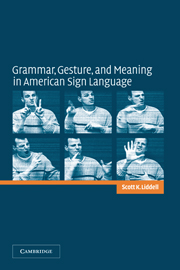Book contents
- Frontmatter
- Contents
- Preface
- Acknowledgments
- 1 American Sign Language as a language
- 2 A sketch of the grammar of ASL
- 3 Pronouns and real space
- 4 Indicating verbs and real space
- 5 Surrogates
- 6 Directing signs at locations and things
- 7 Tokens
- 8 Buoys
- 9 Depicting verbs
- 10 Five brothers
- 11 Grammar, gesture, and meaning
- Appendixes
- References
- General index
- Index of illustrated signs
1 - American Sign Language as a language
Published online by Cambridge University Press: 05 June 2012
- Frontmatter
- Contents
- Preface
- Acknowledgments
- 1 American Sign Language as a language
- 2 A sketch of the grammar of ASL
- 3 Pronouns and real space
- 4 Indicating verbs and real space
- 5 Surrogates
- 6 Directing signs at locations and things
- 7 Tokens
- 8 Buoys
- 9 Depicting verbs
- 10 Five brothers
- 11 Grammar, gesture, and meaning
- Appendixes
- References
- General index
- Index of illustrated signs
Summary
Sign languages have developed spontaneously and independently within communities of Deaf users all over the world. American Sign Language (ASL) is one of those many sign languages. The obvious way that ASL and other sign languages differ from vocally produced languages is the means by which their words are produced and perceived. English words are produced by actions within the vocal tract that result in sounds perceived through audition. Signs – the words of a sign language – are produced by actions of the hands, arms, torso, face, and head that produce signals perceived visually.
There have been, and continue to be, a number of misunderstandings about sign languages. Some people see sign languages as grammarless attempts at communicating through gesture or pantomime. It is not uncommon for a relative or acquaintance to tell a hearing person learning a sign language how wonderful it must be to be able to communicate with people anywhere. Such statements are based on the misconception that sign languages are the same worldwide. The statements also contain a hint of the attitude that sign languages are understandable worldwide because they lack real language properties such as grammar, which would clearly differ from one language to the next.
Another misconception about sign languages is that they are patterned after the vocally produced languages spoken in the same country.
- Type
- Chapter
- Information
- Publisher: Cambridge University PressPrint publication year: 2003



